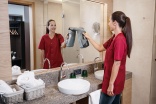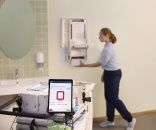Home › magazine › april may 2025 › latest news › The cleanable washroom
The cleanable washroom
9th of June 2025What can be done to ease the task of washroom cleaning? ECJ considers how toilets may be configured and equipped to make them more ‘cleanable’ and finds out about the latest products and systems designed to facilitate the job of sanitising the smallest room.
Hygiene and cleanliness are of paramount importance in the away-from-home washroom. But toilet blocks are often small, cramped spaces that are notoriously difficult to clean.
The sheer volume of traffic makes it hard for cleaners to stay on top of the task. People are continually entering the premises, too, walking in dirt and adding to the mess.
Paper towels and toilet tissue may end up on the floor where they will become soggy and unsightly. Meanwhile, air dryers could be creating puddles on the floor which will spread any mess created. And other issues might include soap spills on the sinks, fingermarks on taps and grout lines that quickly become grubby.
So, what can be done to address these issues and ease the task of washroom cleaning?
Washrooms present a number of unique cleaning challenges, confirms Essity communications director Jenny Turner. “In some areas high foot traffic means the washrooms are almost always in use, and this will lead to frequent messes and limited opportunities for thorough cleaning,” she said. “Restricted space is another key concern since it limits the movement of staff and equipment. And the variety of surfaces in a washroom such as mirrors, stainless steel fixtures and porcelain toilets can be a challenge because each one requires a specific cleaning method and the use of different products.”
Moisture and humidity are further issues since the damp environment will promote the growth of mould and mildew, she says. “Washrooms are also often spread out across a large facility which means cleaning staff will be required to move equipment and supplies over long distances and within challenging layouts,” said Turner.
Some of the problems can be tackled at the design stage, she believes. “Incorporating more space from the outset will allow for easier movement and improved access for cleaning staff,” said Turner. “Providing an adequate level of storage will also reduce the time that needs to be spent on fetching supplies. And continuous surfaces without grout lines will reduce the number of surfaces where dirt and bacteria can accumulate.”
Automatic taps and flush systems will minimise the number of touchpoints and reduce the spread of germs, she says. “However, while architects play a crucial role in designing cleanable washrooms it is also crucial that washroom providers offer systems that are easy to clean,” said Turner. “Choosing materials that are resistant to stains and easy to disinfect can make a significant difference. And all dispensers should offer a high capacity to support efficiencies in maintaining cleanliness and refill availability.”
Real-time data
Regular maintenance and prompt attention to spills and messes can make the task more manageable, she said. “Sensors may also be used for monitoring traffic because this can change cleaning schedules from regular checks to a data-driven plan that will maximise cleaning staff efficiency.”
Tork Vision Cleaning uses real-time data to identify when and where cleaning is needed, she said. Also claimed to ease the cleaning burden are Tork Colour-Coded microfibre cleaning cloths – said to be highly effective at trapping dirt and bacteria – and Tork Easy Handling packaging for soap and paper supplies which is described as being easy to open, transport and dispose of via recycling channels.
Poor lighting, high traffic and challenging surfaces are among the factors that make a washroom particularly difficult to clean, says Kärcher’s cleaning solutions consultant Gundula Braun.“There may also be an unpleasant odour present due to insufficient airflow, inadequate AC systems or malfunctions in the drainage system,” she said.
“Some of the materials used in washroom design can be extremely challenging to clean such as small, high-gloss black marble tiles with white grouting. Meanwhile, the fact that space is limited makes it difficult to use machines in some areas such as beneath toilet bowls, urinals and sinks and around waste containers.
“Water hardness may be a further issue since this will affect the end result. And cross-contamination needs to be avoided which means cleaning need to be precise and the right materials need to be provided.” Almost all washroom cleaning processes need to be carried out manually and operatives are often given a limited amount of time to execute them, she said.
“This may lead to the potential overuse of chemicals because some solutions need time to react on certain surfaces,” said Braun. “Meanwhile, the time constraints may mean the floors are not always rinsed after cleaning. This will result in a build-up of solution on the floor leading to malodours and a sticky floor feeling, which will be unpleasant for staff and washroom users. And once cleanliness has been compromised, people tend not to care so much about their surroundings and this makes the situation worse, creating a vicious circle.”
Cleanability is often the least-considered factor for architects when designing a building, she says. “Washrooms need to be properly lit and have a well-functioning ventilation system to keep moisture levels in check,” she said. “All surfaces and dispensers should be smooth, scratch-resistant, acid-resistant and easy to wipe and clean. And there should be sufficient space provided for waste and hygiene containers.”
Strenuous
The cleaning of toilet bowls is a particularly strenuous task, she said. “This is because an upright body-posture cannot always be assumed while the process is being carried out,” said Braun. “Washrooms also require a great deal of time-consuming detail work such as cleaning door handles, flush systems, taps, dispensers and light switches. And another challenge will be the cleaning of ‘splash zones” which will be created by careless users or after a bodily accident.”
A sensor-supported system that detects levels in soap, and paper dispensers and waste receptacles can help to make the task more efficient, according to Braun. “All cleaning machines should also be compact in size and support the cleaning of smooth surfaces.”
Kärcher provides machines designed to facilitate floor cleaning in areas with restricted access such as the BR 30/1 Bp and BR 30/4 C scrubber dryers and the SG 4/2 and SG 4/4 steam cleaners. The company also offers surface cleaners, trolleys and a wide range of manual tools.
Facilities and cleaning companies need to choose products that are designed to keep spaces cleaner from the outset, says Vectair’s vice-president of marketing Chelsey Schwartz.
“Urinal screens are a critical solution in men’s washrooms to keep the area cleaner by reducing splash-back,” she said. “And easy-to-use feminine hygiene units in the women’s toilets will promote a tidy and more hygienic cubicle space.”
Vectair offers a range of urinal screens as well as the Femcare SIMPLE feminine hygiene unit which incorporates antimicrobial technology and scented liners.
Washrooms are high-traffic areas that require frequent cleaning throughout the day, says Cleanology marketing director Kate Lovell. “The restricted space inside can also make it difficult to operate cleaning equipment and reach all areas,” she said. “And the tiled and grouted surfaces can easily accumulate dirt and grime which means they will require specialised solutions.”
Cleaning the toilets is one of the hardest tasks, she says. “This requires thorough scrubbing and disinfecting to ensure the space is clean and hygienic,” said Lovell. “Polishing the taps is another tough task because they may accumulate water spots and mineral deposits which will give them a dull appearance.”
The floors will quickly become dirty due to spills, dirt and grime, she says. “The damp washroom environment can also lead to mould and mildew growth which needs to be tackled with specialised cleaning products,” adds Lovell. “And areas such as light switches, handles and other frequently-touched surfaces must be cleaned regularly to prevent the spread of germs.”
Implementing features such as enhanced space, automatic taps and easy-to-clean materials at the design stage can significantly reduce cleaning time, she said. “Continuous surfaces will reduce the number of crevices where dirt and bacteria can build, making cleaner quicker and more thorough,” she said. “And touch-free features will reduce the number of fingermarks while proper ventilation will reduce the risk of mould.”
Cleanology provides operatives with compact cleaning machines, long-handled brushes and microfibre cloths designed to ease the task for the operator. The company also provides products that use biotechnology to remove dirt, grease, grime, scale and odour.
Top tips
So, what are our commentators’ top tips for making a washroom more cleanable? It is important to establish a regular routine, says Lovell. “Cleaning the space regularly will limit the build-up of dirt and grime and ensure each session is less intensive,” she said. “Specialised equipment such as long-handled brushes and microfibre cloths will ensure all staff are able to clean effectively and reach difficult areas. High quality products should be used on toilets and grout lines and for removing mould. And thorough training should be provided to all operatives.”
The choice of washroom materials will dictate the ease or otherwise of the challenge, says Kärcher’s Gundula Braun. “Cleaning trolleys should be compact and well stocked, ideally with pre-moistened wipes and cloths to reduce the risk of cross-contamination and improve performance,” she said. “And the premises should be well lit and the waste containers must be easy to empty.”
Essity’s Jenny Turner agrees the choice of fixtures and fittings is pivotal. “All dispensers and surfaces should be easy to access, clean and refill in order to provide efficiency and ergonomic benefits for cleaning staff,” she said. “Operatives should also receive training on how to use the equipment and how to approach the workflow of each area to be cleaned. And the use of high-quality products will make a significant difference.”










